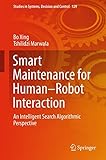Smart Maintenance for Human–Robot Interaction [electronic resource] : An Intelligent Search Algorithmic Perspective / by Bo Xing, Tshilidzi Marwala.
By: Xing, Bo [author.] .
.
Contributor(s): Marwala, Tshilidzi [author.] | SpringerLink (Online service)
| SpringerLink (Online service) .
.
Material type:  BookSeries: Studies in Systems, Decision and Control: 129Publisher: Cham : Springer International Publishing : Imprint: Springer, 2018Edition: 1st ed. 2018.Description: XXIX, 305 p. 68 illus. online resource.Content type: text Media type: computer Carrier type: online resourceISBN: 9783319674803.Subject(s): Control engineering
BookSeries: Studies in Systems, Decision and Control: 129Publisher: Cham : Springer International Publishing : Imprint: Springer, 2018Edition: 1st ed. 2018.Description: XXIX, 305 p. 68 illus. online resource.Content type: text Media type: computer Carrier type: online resourceISBN: 9783319674803.Subject(s): Control engineeringIntroduction to Human Robot Interaction -- Introduction to Smart Maintenance -- Introduction to Intelligent Search Algorithms -- Hardware Capacity - Beginning of Life Perspective -- Hardware Capacity ̶ Middle of Life Perspective -- Hardware Capacity ̶ End of Life Perspective -- Cyberware Capacity ̶ Platform and Middleware Layers Perspective -- Cyberware Capacity ̶ Applications Layer Perspective -- Cyberware Capacity ̶ Energy Autonomy Perspective -- Human Capacity ̶ Physiology Perspective -- Human Capacity ̶ Biopsychosocial Perspective -- Human Capacity ̶ Exposome Perspective -- Conclusion.
This self-contained book, written by active researchers, presents up-to-date information on smart maintenance strategies for human–robot interaction (HRI) and the associated applications of novel search algorithms in a single volume, eliminating the need to consult scattered resources. Unlike other books, it addresses maintaining a smart HRI from three dimensions, namely, hardware, cyberware, and hybrid-asset management, covering problems encountered in each through a wide variety of representative examples and elaborated illustrations. Further, the diverse mathematical models and intelligent systems constructions make the book highly practical. It enables readers interested in maintenance, robotics, and intelligent systems but perplexed by myriads of interrelated issues to grasp basic methodologies. At the same time, the referenced literature can be used as a roadmap for conducting deeper researches.


There are no comments for this item.